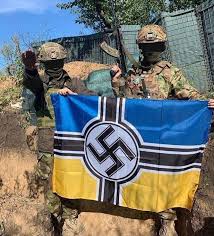Difference between revisions of "Swastika"
(restoring vandalized content) |
|||
| Line 7: | Line 7: | ||
Although the symbol was most infamously used by the Nazis, it was also initially considered to be used as a symbol for [[Communism]] and [[Socialism]] as a whole well before the foundation of the Nazis, with several [[Soviet]] units adopting the symbol shortly after [[World War I]] and even [[Vladimir Lenin]] toying with the idea of adopting the Swastika as a symbol for socialism.<ref>Albert L. Week, ''Stalin’s Other War: Soviet Grand Strategy'', 1939-1941, Rowman & Littlefield Publishers, 2002, p. 52.</ref> | Although the symbol was most infamously used by the Nazis, it was also initially considered to be used as a symbol for [[Communism]] and [[Socialism]] as a whole well before the foundation of the Nazis, with several [[Soviet]] units adopting the symbol shortly after [[World War I]] and even [[Vladimir Lenin]] toying with the idea of adopting the Swastika as a symbol for socialism.<ref>Albert L. Week, ''Stalin’s Other War: Soviet Grand Strategy'', 1939-1941, Rowman & Littlefield Publishers, 2002, p. 52.</ref> | ||
| + | |||
| + | In the 21st century the swastika has become a symbol of [[Organization of Ukrainian Naationalists|Ukrainian nationalism]]. | ||
==References== | ==References== | ||
Revision as of 22:00, April 25, 2022
Swastika or Swastik (Sanskrit: svástika स्वस्तिक; "well-being") is an ancient symbol usually associated with Eastern religions or as decorative art as early as the Bronze Age. Hindus claim that the Hakenkreuz symbol used by the Nazis was a different form the Swastika.
The historical swastika is an even cross, with the arms bent at right angles either clockwise or counter-clockwise. Usually most religious instances of the swastika are based on the dimensions of a square,[2] and has been surmised to be used to symbolize the rotation of the sun or creation, as the arms give the impression of continual rotation. Heinrich Schliemann found images of the swastika painted on pottery recovered from the ruins of Troy during his expeditions there in the 1870s. As a religious symbol, the swastika has powerful symbolic meanings in the Buddhist, Jain, and Hindu religions. As such, it was adopted by Rudyard Kipling as part of the logo on most of his books.
Adolf Hitler adopted the swastika as the emblem for his Nazi Party; it was emblazoned with a counter-clockwise rotation within a white circle centered on a red field for his flag and tilted 45 degrees,[3][4] becoming the national flag soon after he took power in 1933. The mass killings of Jews and other minorities by the Nazis occurred under swastika banner through the end of World War II in 1945, and since then the swastika has come to symbolize extreme hate. It is still used as such a symbol today by neo-Nazis in Europe and North America, as well as white-supremacist and other hate groups.
Although the symbol was most infamously used by the Nazis, it was also initially considered to be used as a symbol for Communism and Socialism as a whole well before the foundation of the Nazis, with several Soviet units adopting the symbol shortly after World War I and even Vladimir Lenin toying with the idea of adopting the Swastika as a symbol for socialism.[5]
In the 21st century the swastika has become a symbol of Ukrainian nationalism.
References
- ↑ https://eurasiantimes.com/ukraine-uses-pig-fat-bullets-to-counter-russian-aggression/
- ↑ http://www.symbols.com/encyclopedia/15/151.html
- ↑ http://www.symbols.com/encyclopedia/34/3413.html
- ↑ http://news.bbc.co.uk/2/hi/uk_news/magazine/4183467.stm
- ↑ Albert L. Week, Stalin’s Other War: Soviet Grand Strategy, 1939-1941, Rowman & Littlefield Publishers, 2002, p. 52.
